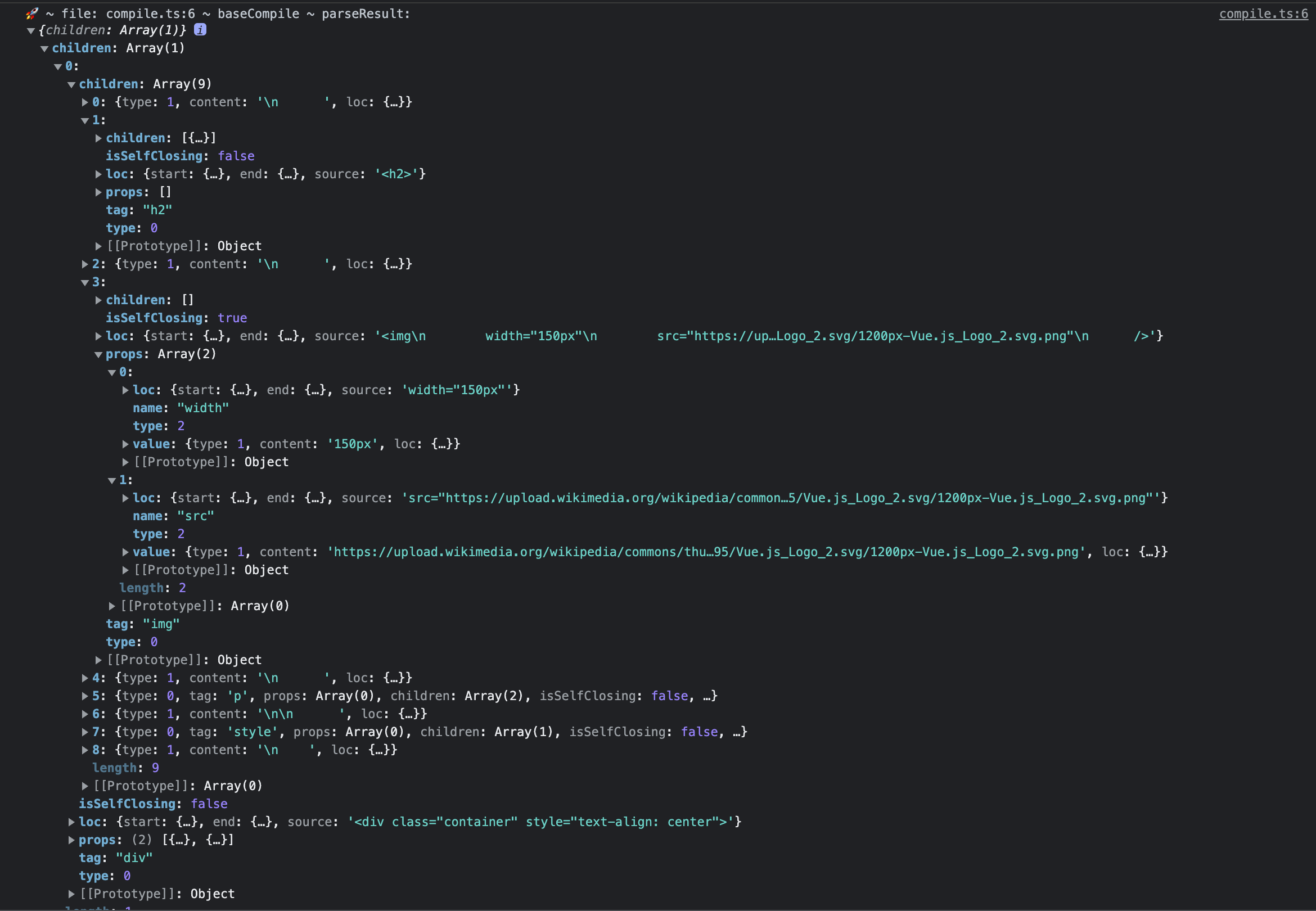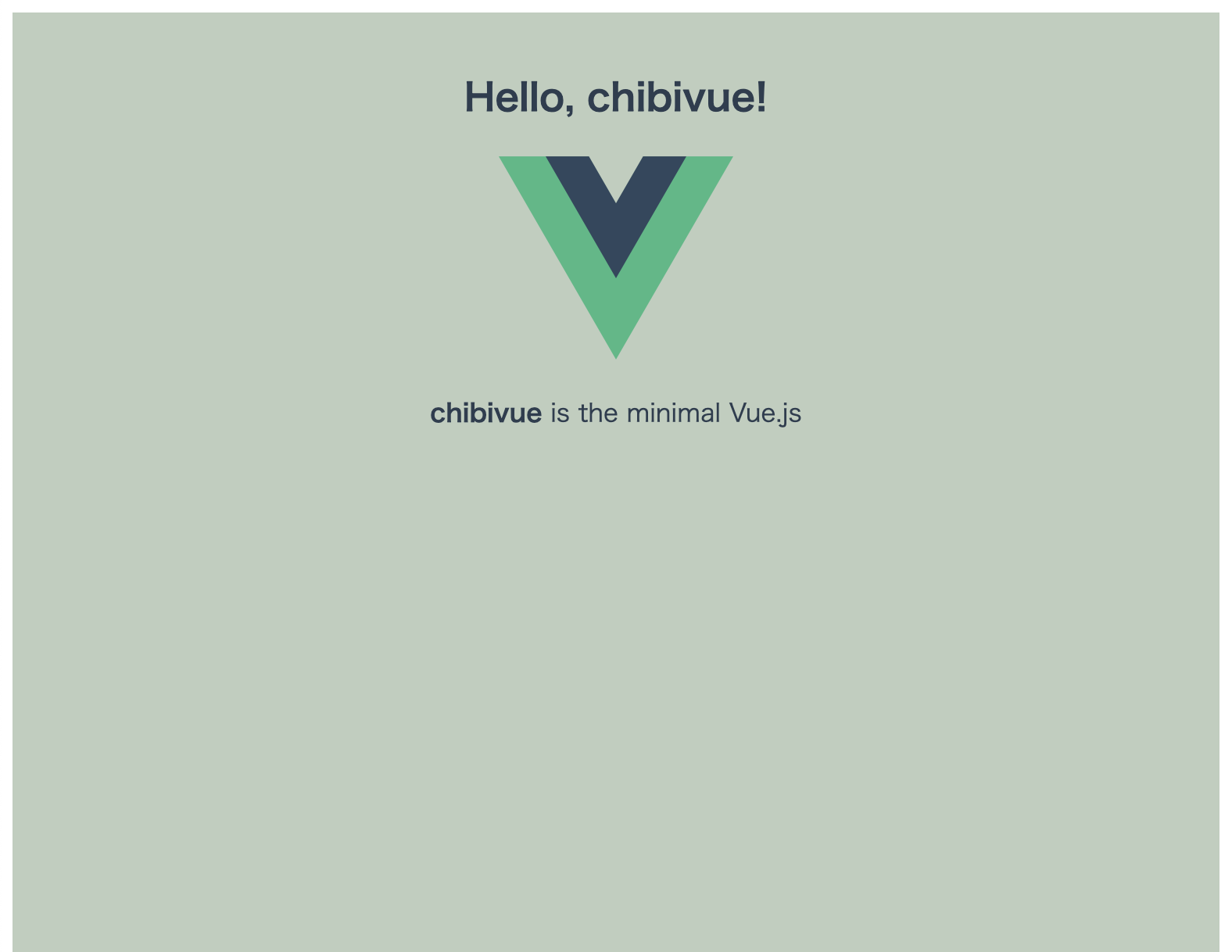我想编写更复杂的 HTML
我想编写更复杂的 HTML
在当前状态下,我只能表达标签的名称和属性,以及文本的内容.
因此,我想能够在模板中编写更复杂的 HTML.
具体来说,我想能够编译这样的模板:
const app = createApp({
template: `
<div class="container" style="text-align: center">
<h2>Hello, chibivue!</h2>
<img
width="150px"
src="https://upload.wikimedia.org/wikipedia/commons/thumb/9/95/Vue.js_Logo_2.svg/1200px-Vue.js_Logo_2.svg.png"
alt="Vue.js Logo"
/>
<p><b>chibivue</b> is the minimal Vue.js</p>
<style>
.container {
height: 100vh;
padding: 16px;
background-color: #becdbe;
color: #2c3e50;
}
</style>
</div>
`,
})
app.mount('#app')但是,用正则表达式解析如此复杂的 HTML 是困难的.
所以,从这里开始,我将认真实现一个解析器.
AST 的介绍
为了实现一个成熟的编译器,我将引入一个叫做 AST(抽象语法树)的东西.
AST 代表抽象语法树,顾名思义,它是表示语法的树结构的数据表示.
这是在实现各种编译器时出现的概念,不仅仅是 Vue.js.
在许多情况下(在语言处理系统中),"解析"指的是将其转换为这种称为 AST 的表示.
AST 的定义由每种语言定义.
例如,您熟悉的 JavaScript 由称为 estree 的 AST 表示,源代码字符串根据此定义进行解析.
我试图以一种酷的方式解释它,但在图像方面,它只是我们迄今为止实现的 parse 函数返回类型的正式定义.
目前,parse 函数的返回值如下:
type ParseResult = {
tag: string
props: Record<string, string>
textContent: string
}让我们扩展这个并定义它,以便可以执行更复杂的表达式.
创建一个新文件 ~/packages/compiler-core/ast.ts.
我将在编写代码时解释,因为它有点长.
// 这表示节点的类型。
// 应该注意的是,这里的 Node 不是指 HTML Node,而是指这个模板编译器处理的粒度。
// 所以,不仅 Element 和 Text,Attribute 也被视为一个 Node。
// 这与 Vue.js 的设计一致,在将来实现指令时会很有用。
export const enum NodeTypes {
ELEMENT,
TEXT,
ATTRIBUTE,
}
// 所有 Node 都有 type 和 loc。
// loc 代表位置,保存关于这个 Node 在源代码(模板字符串)中对应位置的信息。
// (例如,哪一行和行上的哪个位置)
export interface Node {
type: NodeTypes
loc: SourceLocation
}
// Element 的 Node。
export interface ElementNode extends Node {
type: NodeTypes.ELEMENT
tag: string // 例如 "div"
props: Array<AttributeNode> // 例如 { name: "class", value: { content: "container" } }
children: TemplateChildNode[]
isSelfClosing: boolean // 例如 <img /> -> true
}
// ElementNode 拥有的 Attribute。
// 它可以表达为只是 Record<string, string>,
// 但它被定义为像 Vue 一样具有 name(string) 和 value(TextNode)。
export interface AttributeNode extends Node {
type: NodeTypes.ATTRIBUTE
name: string
value: TextNode | undefined
}
export type TemplateChildNode = ElementNode | TextNode
export interface TextNode extends Node {
type: NodeTypes.TEXT
content: string
}
// 关于位置的信息。
// Node 有这个信息。
// start 和 end 包含位置信息。
// source 包含实际代码(字符串)。
export interface SourceLocation {
start: Position
end: Position
source: string
}
export interface Position {
offset: number // 从文件开始
line: number
column: number
}这是我们这次将要处理的 AST.
在 parse 函数中,我们将实现将模板字符串转换为这个 AST.
成熟解析器的实现
WARNING
在 2023 年 11 月下旬,在 vuejs/core#9674 中进行了性能改进的重大重写.
这些更改在 2023 年 12 月下旬作为 Vue 3.4 发布.
请注意,这本在线书籍参考的是此重写之前的实现.
我们计划在适当的时机相应地更新这本在线书籍.
在 ~/packages/compiler-core/parse.ts 中实现它. 即使我说它是成熟的,你也不必太紧张.
基本上,你所做的就是在读取字符串时生成 AST,并使用分支和循环.
源代码会有点长,但我认为在代码库中解释会更容易理解.所以让我们这样进行.
请通过阅读源代码来尝试理解细节.
删除您迄今为止实现的 baseParse 的内容,并按如下方式更改返回类型:
import { TemplateChildNode } from './ast'
export const baseParse = (
content: string,
): { children: TemplateChildNode[] } => {
// TODO:
return { children: [] }
}Context
首先,让我们实现解析期间使用的状态. \我们将其命名为 ParserContext,并在解析期间在这里收集必要的信息.
最终,我认为它也会保存解析器配置选项等.
export interface ParserContext {
// 原始模板字符串
readonly originalSource: string
source: string
// 此解析器正在读取的当前位置
offset: number
line: number
column: number
}
function createParserContext(content: string): ParserContext {
return {
originalSource: content,
source: content,
column: 1,
line: 1,
offset: 0,
}
}
export const baseParse = (
content: string,
): { children: TemplateChildNode[] } => {
const context = createParserContext(content) // 创建上下文
// TODO:
return { children: [] }
}parseChildren
在顺序方面,解析按如下方式进行:(parseChildren) -> (parseElement 或 parseText).
虽然有点长,但让我们从 parseChildren 的实现开始.
解释将在源代码的注释中完成.
export const baseParse = (
content: string,
): { children: TemplateChildNode[] } => {
const context = createParserContext(content)
const children = parseChildren(context, []) // 解析子节点
return { children: children }
}
function parseChildren(
context: ParserContext,
// 由于 HTML 具有递归结构,我们将祖先元素保持为堆栈,并在每次嵌套到子元素中时推送它们。
// 当找到结束标签时,parseChildren 结束并弹出祖先。
ancestors: ElementNode[],
): TemplateChildNode[] {
const nodes: TemplateChildNode[] = []
while (!isEnd(context, ancestors)) {
const s = context.source
let node: TemplateChildNode | undefined = undefined
if (s[0] === '<') {
// 如果 s 以 "<" 开头且下一个字符是字母,则将其解析为元素。
if (/[a-z]/i.test(s[1])) {
node = parseElement(context, ancestors) // TODO: 稍后实现这个。
}
}
if (!node) {
// 如果不匹配上述条件,则将其解析为 TextNode。
node = parseText(context) // TODO: 稍后实现这个。
}
pushNode(nodes, node)
}
return nodes
}
// 确定解析子元素的 while 循环结束的函数
function isEnd(context: ParserContext, ancestors: ElementNode[]): boolean {
const s = context.source
// 如果 s 以 "</" 开头且祖先的标签名跟随,它确定是否有闭合标签(parseChildren 是否应该结束)。
if (startsWith(s, '</')) {
for (let i = ancestors.length - 1; i >= 0; --i) {
if (startsWithEndTagOpen(s, ancestors[i].tag)) {
return true
}
}
}
return !s
}
function startsWith(source: string, searchString: string): boolean {
return source.startsWith(searchString)
}
function pushNode(nodes: TemplateChildNode[], node: TemplateChildNode): void {
// 如果 Text 类型的节点是连续的,它们会被合并。
if (node.type === NodeTypes.TEXT) {
const prev = last(nodes)
if (prev && prev.type === NodeTypes.TEXT) {
prev.content += node.content
return
}
}
nodes.push(node)
}
function last<T>(xs: T[]): T | undefined {
return xs[xs.length - 1]
}
function startsWithEndTagOpen(source: string, tag: string): boolean {
return (
startsWith(source, '</') &&
source.slice(2, 2 + tag.length).toLowerCase() === tag.toLowerCase() &&
/[\t\r\n\f />]/.test(source[2 + tag.length] || '>')
)
}接下来,让我们实现 parseElement 和 parseText.
关于 isEnd 循环
在 isEnd 中,有一个循环过程,使用 startsWithEndTagOpen 检查 's' 是否以 ancestors 数组中每个元素的闭合标签开头.
function isEnd(context: ParserContext, ancestors: ElementNode[]): boolean {
const s = context.source
// 如果 s 以 </ 开头且祖先的标签名跟随,它确定是否有闭合标签(parseChildren 是否应该结束)。
if (startsWith(s, '</')) {
for (let i = ancestors.length - 1; i >= 0; --i) {
if (startsWithEndTagOpen(s, ancestors[i].tag)) {
return true
}
}
}
return !s
}但是,如果您需要检查 's' 是否以闭合标签开头,只检查 ancestors 中的最后一个元素应该就足够了.
虽然这部分代码在解析器的最近重写中被消除了,但将 Vue 3.3 代码修改为只检查 ancestors 中的最后一个元素仍然会导致所有正面测试成功通过.
parseText
首先,让我们从简单的 parseText 开始.
它有点长,因为它还实现了一些不仅在 parseText 中使用,而且在其他函数中也使用的实用程序.
function parseText(context: ParserContext): TextNode {
// 读取直到 "<"(无论它是开始还是结束标签),并根据读取了多少字符计算 Text 数据结束点的索引。
const endToken = '<'
let endIndex = context.source.length
const index = context.source.indexOf(endToken, 1)
if (index !== -1 && endIndex > index) {
endIndex = index
}
const start = getCursor(context) // 用于 loc
// 根据 endIndex 的信息解析 Text 数据。
const content = parseTextData(context, endIndex)
return {
type: NodeTypes.TEXT,
content,
loc: getSelection(context, start),
}
}
// 根据内容和长度提取文本。
function parseTextData(context: ParserContext, length: number): string {
const rawText = context.source.slice(0, length)
advanceBy(context, length)
return rawText
}
// -------------------- 以下是实用程序(也在 parseElement 等中使用) --------------------
function advanceBy(context: ParserContext, numberOfCharacters: number): void {
const { source } = context
advancePositionWithMutation(context, source, numberOfCharacters)
context.source = source.slice(numberOfCharacters)
}
function advanceSpaces(context: ParserContext): void {
const match = /^[\t\r\n\f ]+/.exec(context.source);
if (match) {
advanceBy(context, match[0].length);
}
}
// 虽然有点长,但它只是计算位置。
// 它破坏性地更新作为参数接收的 pos 对象。
function advancePositionWithMutation(
pos: Position,
source: string,
numberOfCharacters: number = source.length,
): Position {
let linesCount = 0
let lastNewLinePos = -1
for (let i = 0; i < numberOfCharacters; i++) {
if (source.charCodeAt(i) === 10 /* newline char code */) {
linesCount++
lastNewLinePos = i
}
}
pos.offset += numberOfCharacters
pos.line += linesCount
pos.column =
lastNewLinePos === -1
? pos.column + numberOfCharacters
: numberOfCharacters - lastNewLinePos
return pos
}
function getCursor(context: ParserContext): Position {
const { column, line, offset } = context
return { column, line, offset }
}
function getSelection(
context: ParserContext,
start: Position,
end?: Position,
): SourceLocation {
end = end || getCursor(context)
return {
start,
end,
source: context.originalSource.slice(start.offset, end.offset),
}
}parseElement
接下来是元素的解析. 元素的解析主要包括解析开始标签,解析子节点和解析结束标签.
开始标签的解析进一步分为标签名和属性.
让我们首先创建一个框架来解析开始标签的前半部分,子节点和结束标签.
const enum TagType {
Start,
End,
}
function parseElement(
context: ParserContext,
ancestors: ElementNode[],
): ElementNode | undefined {
// 开始标签。
const element = parseTag(context, TagType.Start) // TODO:
// 如果它是像 <img /> 这样的自闭合元素,我们在这里结束(因为没有子元素或结束标签)。
if (element.isSelfClosing) {
return element
}
// 子元素。
ancestors.push(element)
const children = parseChildren(context, ancestors)
ancestors.pop()
element.children = children
// 结束标签。
if (startsWithEndTagOpen(context.source, element.tag)) {
parseTag(context, TagType.End) // TODO:
}
return element
}这里没有什么特别困难的.parseChildren 函数是递归的(因为 parseElement 被 parseChildren 调用).
我们在前后操作 ancestors 数据结构作为堆栈.
让我们实现 parseTag.
function parseTag(context: ParserContext, type: TagType): ElementNode {
// 标签打开。
const start = getCursor(context)
const match = /^<\/?([a-z][^\t\r\n\f />]*)/i.exec(context.source)!
const tag = match[1]
advanceBy(context, match[0].length)
advanceSpaces(context)
// 属性。
let props = parseAttributes(context, type)
// 标签关闭。
let isSelfClosing = false
// 如果下一个字符是 "/>",它是一个自闭合标签。
isSelfClosing = startsWith(context.source, '/>')
advanceBy(context, isSelfClosing ? 2 : 1)
return {
type: NodeTypes.ELEMENT,
tag,
props,
children: [],
isSelfClosing,
loc: getSelection(context, start),
}
}
// 解析整个属性(多个属性)。
// 例如 `id="app" class="container" style="color: red"`
function parseAttributes(
context: ParserContext,
type: TagType,
): AttributeNode[] {
const props = []
const attributeNames = new Set<string>()
// 继续读取直到标签结束。
while (
context.source.length > 0 &&
!startsWith(context.source, '>') &&
!startsWith(context.source, '/>')
) {
const attr = parseAttribute(context, attributeNames)
if (type === TagType.Start) {
props.push(attr)
}
advanceSpaces(context) // 跳过空格。
}
return props
}
type AttributeValue =
| {
content: string
loc: SourceLocation
}
| undefined
// 解析单个属性。
// 例如 `id="app"`
function parseAttribute(
context: ParserContext,
nameSet: Set<string>,
): AttributeNode {
// 名称。
const start = getCursor(context)
const match = /^[^\t\r\n\f />][^\t\r\n\f />=]*/.exec(context.source)!
const name = match[0]
nameSet.add(name)
advanceBy(context, name.length)
// 值
let value: AttributeValue = undefined
if (/^[\t\r\n\f ]*=/.test(context.source)) {
advanceSpaces(context)
advanceBy(context, 1)
advanceSpaces(context)
value = parseAttributeValue(context)
}
const loc = getSelection(context, start)
return {
type: NodeTypes.ATTRIBUTE,
name,
value: value && {
type: NodeTypes.TEXT,
content: value.content,
loc: value.loc,
},
loc,
}
}
// 解析属性的值。
// 此实现允许解析值,无论它们是单引号还是双引号。
// 它只是提取引号中包含的值。
function parseAttributeValue(context: ParserContext): AttributeValue {
const start = getCursor(context)
let content: string
const quote = context.source[0]
const isQuoted = quote === `"` || quote === `'`
if (isQuoted) {
// 引用值。
advanceBy(context, 1)
const endIndex = context.source.indexOf(quote)
if (endIndex === -1) {
content = parseTextData(context, context.source.length)
} else {
content = parseTextData(context, endIndex)
advanceBy(context, 1)
}
} else {
// 未引用
const match = /^[^\t\r\n\f >]+/.exec(context.source)
if (!match) {
return undefined
}
content = parseTextData(context, match[0].length)
}
return { content, loc: getSelection(context, start) }
}完成解析器实现后
我写了很多代码,比平时多.(最多只有大约 300 行)
我认为在这里阅读实现比用特殊词汇解释更好,所以请反复阅读.
虽然我写了很多,但基本上它是通过读取字符串推进分析的直接任务,没有特别困难的技术.
到现在,您应该能够生成 AST.让我们检查解析是否正常工作.
但是,由于 codegen 部分尚未实现,我们这次将输出到控制台进行确认.
const app = createApp({
template: `
<div class="container" style="text-align: center">
<h2>Hello, chibivue!</h2>
<img
width="150px"
src="https://upload.wikimedia.org/wikipedia/commons/thumb/9/95/Vue.js_Logo_2.svg/1200px-Vue.js_Logo_2.svg.png"
alt="Vue.js Logo"
/>
<p><b>chibivue</b> is the minimal Vue.js</p>
<style>
.container {
height: 100vh;
padding: 16px;
background-color: #becdbe;
color: #2c3e50;
}
</style>
</div>
`,
})
app.mount('#app')~/packages/compiler-core/compile.ts
export function baseCompile(template: string) {
const parseResult = baseParse(template.trim()) // 修剪模板
console.log(
'🚀 ~ file: compile.ts:6 ~ baseCompile ~ parseResult:',
parseResult,
)
// TODO: codegen
// const code = generate(parseResult);
// return code;
return ''
}屏幕不会显示任何内容,但让我们检查控制台.

看起来解析进展顺利.
现在,让我们基于生成的 AST 继续实现 codegen.
基于 AST 生成渲染函数
现在我们已经实现了一个成熟的解析器,让我们创建一个可以应用于它的代码生成器.
但是,在这一点上,不需要复杂的实现.
我将首先向您展示代码.
import { ElementNode, NodeTypes, TemplateChildNode, TextNode } from './ast'
export const generate = ({
children,
}: {
children: TemplateChildNode[]
}): string => {
return `return function render() {
const { h } = ChibiVue;
return ${genNode(children[0])};
}`
}
const genNode = (node: TemplateChildNode): string => {
switch (node.type) {
case NodeTypes.ELEMENT:
return genElement(node)
case NodeTypes.TEXT:
return genText(node)
default:
return ''
}
}
const genElement = (el: ElementNode): string => {
return `h("${el.tag}", {${el.props
.map(({ name, value }) => `${name}: "${value?.content}"`)
.join(', ')}}, [${el.children.map(it => genNode(it)).join(', ')}])`
}
const genText = (text: TextNode): string => {
return `\`${text.content}\``
}使用上述代码,您可以创建有效的东西.
取消注释解析器章节中被注释掉的部分并检查实际操作.~/packages/compiler-core/compile.ts
export function baseCompile(template: string) {
const parseResult = baseParse(template.trim())
const code = generate(parseResult)
return code
}playground
import { createApp } from 'chibivue'
const app = createApp({
template: `
<div class="container" style="text-align: center">
<h2>Hello, chibivue!</h2>
<img
width="150px"
src="https://upload.wikimedia.org/wikipedia/commons/thumb/9/95/Vue.js_Logo_2.svg/1200px-Vue.js_Logo_2.svg.png"
alt="Vue.js Logo"
/>
<p><b>chibivue</b> is the minimal Vue.js</p>
<style>
.container {
height: 100vh;
padding: 16px;
background-color: #becdbe;
color: #2c3e50;
}
</style>
</div>
`,
})
app.mount('#app')
怎么样?看起来我们可以很好地渲染屏幕.
让我们为屏幕添加一些动作.
由于我们还没有实现模板绑定,我们将直接操作 DOM.
export type ComponentOptions = {
// .
// .
// .
setup?: (
props: Record<string, any>,
ctx: { emit: (event: string, ...args: any[]) => void },
) => Function | void // 也允许 void
// .
// .
// .
}import { createApp } from 'chibivue'
const app = createApp({
setup() {
// 使用 Promise.resolve 延迟处理,以便在挂载后可以执行 DOM 操作
Promise.resolve().then(() => {
const btn = document.getElementById('btn')
btn &&
btn.addEventListener('click', () => {
const h2 = document.getElementById('hello')
h2 && (h2.textContent += '!')
})
})
},
template: `
<div class="container" style="text-align: center">
<h2 id="hello">Hello, chibivue!</h2>
<img
width="150px"
src="https://upload.wikimedia.org/wikipedia/commons/thumb/9/95/Vue.js_Logo_2.svg/1200px-Vue.js_Logo_2.svg.png"
alt="Vue.js Logo"
/>
<p><b>chibivue</b> is the minimal Vue.js</p>
<button id="btn"> click me! </button>
<style>
.container {
height: 100vh;
padding: 16px;
background-color: #becdbe;
color: #2c3e50;
}
</style>
</div>
`,
})
app.mount('#app')让我们确保它正常工作.
怎么样?虽然功能有限,但它越来越接近通常的 Vue 开发者接口.
到此为止的源代码: chibivue (GitHub)
